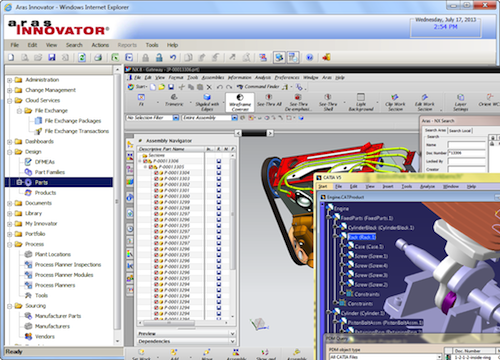Aras Bears Down on the Problem of Multi-CAD Data Management
Latest News
August 7, 2013
Managing CAD files from diverse CAD systems remains one of the on-going pain points for engineering organizations, despite the myriad solutions that attempt to address the issue.
For years, the vendor community either overlooked or under solved the problem, hoping their customers would be content to live in a homogeneous CAD world. With global, oftentimes, cross-company engineering efforts now the norm today, CAD vendors have come to grips with the fact that multi-CAD is here to stay and the onus is on them to provide a harmonious environment if they want to keep customers satisfied and remain competitive in the market.
Aras, best known for championing open source and more recently, cloud-based PLM, is the latest vendor to trumpet the multi-CAD cause, adding an array of enhancements in its latest release to improve the performance of multi-CAD data management. Aras 9.4, the company’s major release for the year, employs what company President Peter Schroer says is “clever things with files,” including compression techniques and advances in the area of asynchronous multithreading, to achieve significant performance gains for managing diverse CAD files in very large assemblies.
“How can customers get a single, homogeneous view of an assembly structure or bill of materials when the data is coming from many different CAD systems,” notes Schroer. “It’s a complex problem in terms of how to coordinate the many different CAD systems.”
It’s a complex problem Aras set out to tackle, mostly because its customers were asking for help in this area, Schroer says. “Our customers were telling us they had lots of pain, not just in merging data, but in working with large CAD files and structures—say those with 8,000 to 10,000 parts in an assembly,” he explains. “They say performance is terrible.”
With engineers focused on solving the problem, Aras learned that the meta data describing the structure of the assembly—for example, the information that specifies which of those 8,000 to 10,000 parts go where—was the root cause of much of the performance pain. By adjusting how users navigate the product structure, Aras was able to achieve a significant impact on multi-CAD management performance—to the tune of a 10X increase in speed, a 10X reduction in memory, and 6X smaller AML/XML package size, Schroer says. There are also new check-in/check-out capabilities designed to streamline and automate the process for the entire CAD assembly structure, including high-performance, parallel, asynchronous file check-ins for each level of the CAD structure.
T-Systems International, an Aras partner for PLM, validated some of Aras’ claims with a PLM replacement project conducted in 2012. The integrator was looking to migrate a customer’s existing PLM implementation of 2.8 million records, including 350,000 CATIA V5 CAD files, to the Aras platform. A series of performance tests, used to validate the migration, found on average anywhere between 14% and 81% performance gains when working with very large CAD assemblies.
Along with the performance improvements, Aras Innovator 9.4 delivers a number of other improvements, including expanded Microsoft platform support, new user personalization and configuration capabilities, and cloud-based, secure file exchange thanks to a relationship with Trubiquity. Aras has embedded Trubiquity’s TRUaras secure, cloud-based managed file transfer capabilities into the Aras platform. Working similarly to Dropbox, a popular cloud-based file sharing service, Trubiquity is architected for sharing large CAD assemblies, technical data packages, manufacturing data, and inspection and test results with full tracking and traceability. TRUaras will be included in every Aras download. It is a free service covering unlimited transactions with no file size limits.
For a look at Aras’ vision of multiCAD and visual collaboration, check out the video below.
Subscribe to our FREE magazine, FREE email newsletters or both!
Latest News
About the Author
Beth Stackpole is a contributing editor to Digital Engineering. Send e-mail about this article to [email protected].
Follow DE






